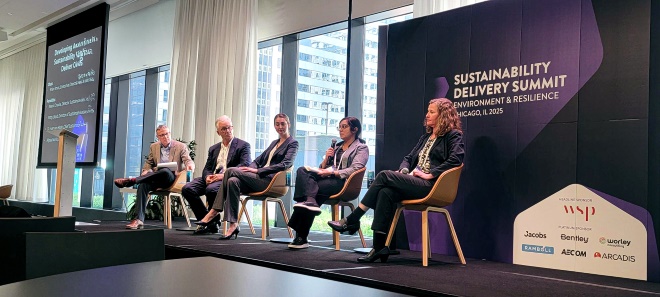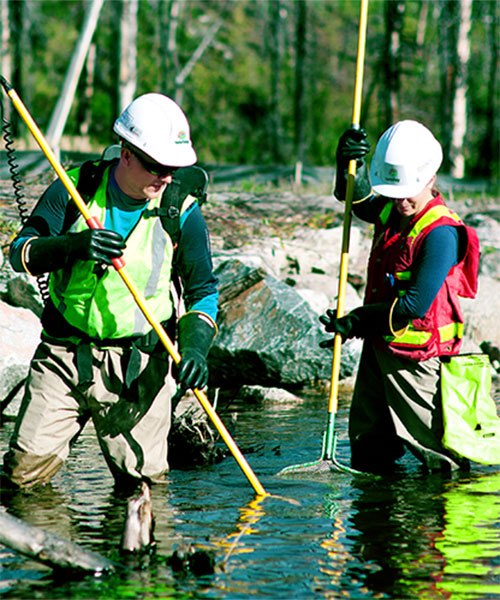June 26, 2025 • 4 min read
Advancing through uncertainty: Insights from the Sustainability Delivery Summit
The 2025 Sustainability Delivery Summit in Chicago gathered industry leaders to discuss the practical realities of supporting the development and delivery of resilient infrastructure. How can organizations maintain momentum when policies shift, costs rise, and the path forward isn’t always clear?
In today’s asset development landscape, uncertainty is the only constant. The summit’s sessions conveyed a clear message: companies cannot wait for public bodies to lead the way amid political instability, energy volatility, and environmental stewardship goals. Instead, they must design resilient projects and operations to withstand these uncertainties and maintain progress.

Build in sustainability and resilience planning from the onset
Embedding climate resilience and social impact into early project planning is no longer optional. From emissions strategies and energy use to material sourcing and community engagement, these decisions can help shape long-term project viability and investor confidence.
“We’re seeing lenders and investors increasingly prioritizing projects that demonstrate clear sustainability and resilience goals, and strategies to achieve them from the outset,” says Mary Lou Lauria, SVP Environment & Sustainability, Worley Consulting.
“There’s still a drive for low carbon projects,” adds Anne McPhee, SVP Global Asset Development and Operations. “But that momentum now has to come from within companies, not government mandates. That means looking harder at the fundamentals: what will make a project viable in a volatile market? What reduces risk over a 30-year asset life?”
Lead with purpose through uncertainty
The policy landscape is fragmented. Regulation varies across jurisdictions, and government priorities can shift every election cycle. Companies that wait for improved market clarity or stability risk falling behind.
The path forward requires a clear internal compass – grounded in a strong understanding of foundational elements like stakeholder priorities, value chain goals, operational standards and project criteria. And the discipline to stay aligned, even as external conditions evolve.

Champion partnerships
Energy systems, data infrastructure, and supply chains are more interconnected than ever. Projects increasingly require diverse technical capabilities, regional expertise, and community alignment.
“We’ve seen that projects that progress with local community engagement, think beyond employment, and build lasting social value, are better positioned to succeed,” says Lauria.
The most successful organizations are forming ‘unlikely’ partnerships – with peers, competitors, and innovators – to co-develop pathways, unlock funding, and share risk. Collaboration isn’t just efficient, it’s essential.
For example, we’re collaborating with decarbonization technology expert Topsoe to accelerate standardized, modular e‑Methanol production plants in the US Midwest. Our partnership aims to support the shipping industry transition to low carbon fuels while addressing growing demand, with each facility expected to produce up to 600 tonnes of e‑Methanol per day.
“Our customers want integrated thinking, which comes from pulling in the right expertise. We’re building solutions that need to last for decades. And that kind of delivery requires alignment and collaboration,” says McPhee.
Embrace digital and AI to accelerate impact
The rise of AI and digital infrastructure has brought a new urgency to energy-related conversations. As companies race to meet growing demand for datacenters enabling the latest computing innovations, challenges around grid capacity, land use and power sourcing are becoming harder to solve.
Digital tools and artificial intelligence are no longer emerging trends – they’re core enablers of efficient, adaptive infrastructure. From optimizing design and identifying risks to accelerating permitting, these technologies are helping teams streamline delivery and improve decision-making across the project lifecycle. The opportunity lies in scaling these tools from pilots into enterprise-level delivery, unlocking insights across the infrastructure lifecycle.
Drive resilience through action
The energy transition is proving more complex, politically fraught and capital-intensive, but that doesn’t lessen the ambition to deliver on sustainability goals. It just changes the approach. The path to resilient, sustainable infrastructure won’t be linear – but it’s more likely to be navigated by those who act with clarity, collaborate broadly, and act with purpose alongside other key enablers.
Now is the time to double down on what matters: longer-term thinking, digital innovation, and shared success.



